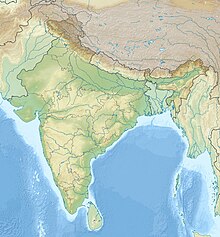Our website is made possible by displaying online advertisements to our visitors.
Please consider supporting us by disabling your ad blocker.
Bhaja Caves
| Bhaje Caves | |
|---|---|
 Main Chaityagrha, Cave 12, with stupa | |
| Location | Pune, Bhaje,[1] Maharashtra, India |
| Coordinates | 18°43′40″N 73°28′55″E / 18.72778°N 73.48194°E |
| Geology | Basalt |
| Entrances | 22 |
| Difficulty | easy |
| Pronunciation | Bhaja or Bhaje |
Bhaja Caves are a group of 22[2] rock-cut caves dating back to the 2nd century BC located off the Mumbai - Pune expressway near the city of Pune, India. The caves are 400 feet above the village of Bhaja,[3] on an important ancient trade route running from the Arabian Sea eastward into the Deccan Plateau (the division between North India and South India).[4] The inscriptions and the cave temple are protected as a Monument of National Importance, by the Archaeological Survey of India per Notification No. 2407-A.[5][6] It belongs to the Early Buddhist schools in Maharashtra.[2] The caves have a number of stupas, one of their significant features. The most prominent excavation is its chaitya (or chaityagrha – Cave XII), a good example of the early development of this form from wooden architecture, with a vaulted horseshoe ceiling. Its vihara (Cave XVIII) has a pillared verandah in front and is adorned with unique reliefs.[7] These caves are notable for their indications of the awareness of wooden architecture.[2] The carvings prove that tabla – a percussion instrument – was used in India for at least 2300 years,[8][9] disproving the centuries-held belief that the tabla was introduced to India by outsiders or from Turko-Arab.[10] The carving shows a woman playing tabla and another woman, performing dance.
They are some 9 km west from the Bedse Caves. Other caves in the area are Karla Caves, Patan Buddhist Cave and Nasik Caves.
- ^ Burgess, James (1880). "The caves in vicinity of Karle and the Bor Ghat". The Cave Temples of India. W.H. Allen. pp. 223–228. Retrieved 5 July 2013.
bhaja .
- ^ a b c "Ticketed Monuments – Maharashtra Bhaja Caves, Bhaja". Archaeological Survey of India, Government of India. Archived from the original on 10 August 2013. Retrieved 5 July 2013.
- ^ "CHAPTER 20 PLACES OF INTEREST". Maharashtra Government – Tourism and Cultural Dept. Retrieved 6 July 2013.
- ^ "Later Andhra Period India". Retrieved 24 January 2007.
- ^ "List of the protected monuments of Mumbai Circle district-wise" (PDF). Archived from the original on 6 June 2013.
- ^ "Bhaja Caves Visitors' Sign". 15 January 2012. Retrieved 8 October 2012.
- ^ Ahir, D. C. (2003). Buddhist sites and shrines in India: history, art, and architecture (1. ed.). Delhi: Sri Satguru Publ. p. 191. ISBN 8170307740.
- ^ Pradipkumar S. Meshram, 1981, [The tabla in the Bhaja cave sculptures: A note], Indica, Volume 18, p. 57.
- ^ Mark Hijleh, 2019, Towards a Global Music History: Intercultural Convergence, Fusion, and Transformation in the Human Musical Story, Routledge, NY, USA.
- ^ 1999, Parsiana, volume 22, p. 49.
Previous Page Next Page



